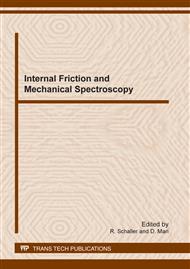p.257
p.265
p.271
p.277
p.283
p.289
p.295
p.301
p.307
Grain Boundary Relaxation in 18-Carat Yellow Gold
Abstract:
Au60Ag30Cu10 (in at%) gold alloy exhibits a mechanical loss spectrum composed of a Zener peak due to Cu atoms in the solid solution and of a second relaxation peak at higher temperature or lower frequency. It is shown that this second peak is related to the presence of grain boundaries as it is absent in the spectrum of a single crystal. This mechanical loss peak, which is stable and reproducible in heating and cooling cycles, is thermally activated with an activation enthalpy of 2.35 eV and an apparent limit relaxation time of 9.6·10-17s. As it is hard to imagine that a whole grain should slip at once along a touching grain, the relaxation peak is interpreted by a dislocation model, which may account not only for the activation parameters but also for the stress amplitude dependency of the peak.
Info:
Periodical:
Pages:
283-288
Citation:
Online since:
January 2012
Authors:
Keywords:
Price:
Сopyright:
© 2012 Trans Tech Publications Ltd. All Rights Reserved
Share:
Citation:


